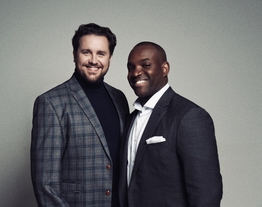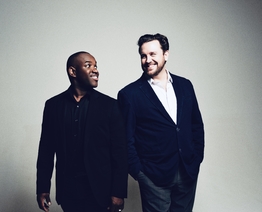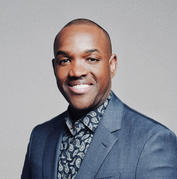

Michael Spyres
News
Contra-Tenor
Defying conventional vocal categories, Michael Spyres won a 2022 Gramophone Award for his album BariTenor. Now, with Contra-Tenor, he challenges perceptions of the tenor in the Baroque era, often seen as the age of the castrato. In the company of Il Pomo d’Oro and conductor Francesco Corti, he explores the period from the late 17th century to the 1770s, tracing the course of opera in both the French and Italian styles. The 15 arias on Contra-Tenor range from Lully to early Mozart by way of Handel, Vivaldi, Rameau, Gluck and composers such as Hasse, Galuppi and Latilla (represented by world premiere recordings), and Mazzoni and Sarro (represented by first studio recordings).
“The fame of the castrati in the mid-1700s has long been established, but very few people realize just how famous their contemporary tenor rivals were,” writes Michael Spyres. “The music written for the tenor superstars [of the time] is virtually unknown. How many music lovers today have even heard of the castrati’s equally famous [tenor] rivals Amorevoli, Babbi, Borosini, Fabri, Jélyotte, Legros, or Raaff? …Those with the greatest technical ability and the broadest range were known as tenore assoluto …. This new type of male singer, born from the Baroque era, would eventually outshine the famous castrati and clear the path for the tenor to assume the role of leading man.
“Juxtaposing virility and strength with sweetness and beauty was thought impossible for the male voice until Raaff, Jélyotte and Amorevoli entered the scene. All the attributes of the castrati – the elegant phrasing, the coloratura fireworks, the dynamic range, the beauty of tone – were equally demanded of the tenore assoluto, but the tenors had a range that no castrato could rival. The rise of the assoluto stretched the limits of the human voice, reaching a superhuman extension of three-and-a-half octaves (from D2 to G5), encompassing the range of the male bass all the way to the female contralto.”
Spyres brings exceptional credentials to this virtuoso repertoire, rising with supreme assurance to the contrasting demands of the French and Italian schools. Praising BariTenor, Gramophone described him as a “superb artist whose voice [is] perfectly equalised over more than two-and-a-half octaves,” notable for “exceptional artistry, formidable technique and seemingly limitless understanding of style.” In a similar vein, the reviewer in Opera magazine wrote that: “The singer’s talent for divining and then becoming the character through responsiveness to the notes and the word seems to me – in the original sense – awesome.”
Handel: Theodora
In November 2021, a starry ‘touring company’ performed Handel’s Theodora in Vienna, Milan, Paris, Luxembourg and Essen. An elevated and moving oratorio, first performed in 1750, it tells the story of Christian martyrs in ancient Antioch under Roman occupation. Theodora was Handel’s penultimate major work and he considered it among his best.
Leading the company was Maxim Emelyanychev in his capacity as Chief Conductor of the instrumentalists and choral singers of Il Pomo d’Oro. Soprano Lisette Oropesa took the role of the noble Theodora, while mezzo-soprano Joyce DiDonato portrayed her friend Irene, a leading light of Antioch’s community of Christians; Didymus, a Roman soldier who loves Theodora, was sung by countertenor Paul-Antoine Bénos-Djian, and his friend Septimius by tenor Michael Spyres, while baritone John Chest held sway as the authoritarian Roman governor Valens.
This recording was made at the performance in Essen. It took place in the acoustically outstanding Alfried Krupp Saal, and was described by the Online Merker as “an evening of top-flight singing of a kind that is only rarely experienced.” The reviewer praised Lisette Oropesa – renowned in such operatic roles as Mozart’s Konstanze, Donizetti’s Lucia and Verdi’s Violetta – for her “dark-toned, full and sensual soprano voice” and “exceptionally refined control of her vocal line”. Joyce DiDonato, meanwhile, demonstrated her “consummate command of the art of 18th century vocal music in all its emotional moods and subtleties” with her “variety of vocal means: dynamic nuance … tone colour, with a spectrum from straight-toned brightness to luscious, vibrant radiance … In the aria ‘As with rosy steps the morn’, DiDonato’s soft shadings evoked the dawn as a reflection of eternal light … Great art in the form of controlled, meditative singing engendered by inner thought.” Michael Spyres, with his “secure, uninhibited high notes, gleaming middle register and sure-fire agility” had “everything it takes to give masterly shape to Handel’s music,” and Paul-Antoine Bénos-Djian was notable for his “even, elegantly produced voice … sparkling like gold brocade in its lower reaches and shimmering like silk in its unforced upper register”. John Chest made an imposing tyrant with his “firm, robust tone” and the chorus “delighted with its bravura phrasing and absolutely clean intonation.” The players of Il Pomo d’Oro offered both “effervescent presence and dramatic accents”.
Earlier in the tour, the performance at the Théâtre des Champs-Élysées in Paris prompted Diapason to say that: “Justifiably, there was a triumphant reception for the interpretation of Maxim Emelyanychev, Il Pomo d’Oro and a stunning line-up of singers.” There was the “astonishing vocal richness of Joyce DiDonato, between vehemence and contained sorrow, breathtaking in the pianissimos,” and the “luminous timbre and delicate top notes of Lisette Oroposa, the ideal representation of the virgin martyr”. Maxim Emelyanychev’s conducting was described as “absolute in its commitment …masterly.” ResMusica judged Michael Spyres’ voice to be “ideal for Handel’s tenor roles … The precision and speed of his coloratura raised the stakes to fine effect,” and praised John Chest for his “rich, strong voice, particularly incisive in its upper reaches.” Crescendo admired the way Paul-Antoine Bénos-Djian applied his “substantial vocal resources with touching musical intelligence and dramatic intensity”, and summed up by saying that, by the end of the evening, the audience was “in a state of bliss … as if floating in the air”.
Rossini: Messa di Gloria
“Rossini’s Messa di Gloria is a mass of light,” says Sir Antonio Pappano. “It’s a Mass that praises the glory of God. It does not include either the Credo or the Crucifixus, with their darker elements, which would be heard in a full Mass. It was premiered in 1820 in a baroque church, San Ferdinando in Naples. When you listen to it, you can imagine the light of the church and the music fusing together beautifully.”
Pappano, as Music Director of Rome’s Chorus and Orchestra dell’Accademia Nazionale di Santa Cecilia, has built a notable discography of Rossini on Warner Classics: the epic opera Guillaume Tell, the Stabat Mater, the Petite Messe Solenelle and an album of operatic overtures. Now, with the Messa di Gloria, he expands it with the only liturgy-based work that Rossini wrote before his early retirement from composing opera, in 1829 when Guillaume Tell had been premiered in Paris and he was just 37 years old.
More rarely heard than the monumental Stabat Mater and the idiosyncratic Petite Messe Solenelle, the nine-movement Messa di Gloria requires five virtuosic vocal soloists. Here, three Italians – soprano Eleonora Buratto, mezzo-soprano Teresa Iervolino and bass Carlo Lepore – are joined by two Americans, Lawrence Brownlee and Michael Spyres, who celebrated Rossini and the star tenors of his era with their thrilling recital album Amici e Rivali, released in 2020. Spyres describes the Messa di Gloria as “some of the most difficult vocal writing Rossini ever penned. He really wanted to glorify the Church and the Word, showing the entire range of every single voice as he did so. It is truly bel canto at its height.”
Pappano is in agreement on the ambitions of the score: “Rossini makes high demands on his orchestra, but in the Messa di Gloria he gave the vocal soloists challenges that even by his standards were extreme – for agility and also colour. I was so lucky I had such a wonderful team of singers … The soloists need to sing with great spiritual fervour and also powerful confidence as they convey the fearlessness of Rossini’s relationship to God.
“This work is a tribute to virtuoso playing and singing, and also a celebration per se, praising God’s glory …With this treatment of the Latin text, the operatic virtuosity in the orchestra and the voices becomes something more than just pyrotechnics: it does and should bring a smile to the listener’s face … I don’t think Rossini was setting out to defy any perceived conventions of sacred music – he just composed this Messa in his natural way, connecting vividly to his audience in his inimitable fashion.
“Despite the speed with which he wrote it, and the obvious bel canto conventions in the singing, this Messa, like all his work, is always surprising ... All the way through there is such fertile inventiveness, and it is glorious to hear the way the Santa Cecilia Orchestra captures Rossini’s lightness. He is a composer who has become very important to me for his elegance, precision, wit, irony and panache … Unlike the Verdi Requiem or the Mozart Requiem, where the fear of God and the Day of Judgement is so intense, fear is not really present in Rossini’s Messa di Gloria. This is a beautiful quality to experience – Rossini is just open eyes, open face, and open arms to God.”
Michael Spyres explores the baritenor as a forgotten vocal phenomenon
An album with a mission to defy classification, BariTenor is a tour de force for Michael Spyres. It ranges wide, encompassing repertoire normally assigned to both tenors and baritones. Programming 18 arias by 15 composers, it covers three centuries of opera in Italian, French and German. Mainstream works are set beside relative rarities with numbers from, among others, Don Giovanni, Pagliacci, Il trovatore, Les Contes d’Hoffmann, Lohengrin (here in a French version), Carmina Burana (officially a ‘scenic cantata’), Rossini’s Otello, Thomas’s Hamlet, Adam’s Le Postillon de Lonjumeau and, quite a rediscovery, Méhul’s Ariodant.
“With this album I am making an honest attempt to explore the baritenor as a forgotten vocal phenomenon,” explains Spyres. “It has been hiding in plain sight within compositions throughout the entirety of opera’s existence.”
Missouri-born Michael Spyres has achieved renown as a multi-faceted tenor, not least through his Erato recordings of works by Berlioz (Les Troyens, La Damnation de Faust and the Grande Messe des Morts, all under the baton of Berlioz specialist John Nelson). Amici e Rivali, the Rossini album he made with fellow tenor Lawrence Brownlee, provides ample evidence of his brilliant high notes. At the same time, his robust lower register gives a clue to his baritone origins.
‘Baritenor’ is the term that Spyres prefers when it comes to describing his voice. This is not one of the ‘official’ voice classifications, but a long-established term that has achieved greater currency over recent decades, notably with the revival of interest in Rossini’s serious operas. Amici e Rivali was partly a tribute to a star singer of Rossini’s time – Andrea Nozzari; he was another ‘baritenor’, and with BariTenor Spyres pays tribute to him and to a succession of singers from history. Among them are the baritones Jean-Blaise Martin, Jean-Baptiste Faure, Victor Maurel and Jean Périer, and the tenors Anton Raaf, Adolphe Nourrit, Giovanni Rubini, Jean-Baptiste Chollet, Mécène Marié de l'Isle (who premiered the stratospheric ‘Ah! mes amis, quel jour de fête!’ from Donizetti’s La Fille du regiment, which features on the album), and Richard Schubert, the first singer of the heldentenor role of Paul in Erich Korngold’s Die tote Stadt: the touching ‘Glück, das mir verblieb’ is another highlight of BariTenor.
“The entire programme is linked by the baritenor technique,” explains Spyres. “Having started off as a baritone, I spent 10 years turning myself into a tenor, and over my career I’ve sung four operas as a baritone compared to about 75 as a tenor. Voices like mine have existed as long as opera has existed, but most singers are used to being labelled in a certain Fach [the German word for ‘compartment’ or ‘specialisation’] and have forgotten that they have a much larger range. When I sing as a baritone rather than as a tenor, I produce the sound in a slightly different way and treat the passaggio [the transition between vocal registers] differently. On this album I sing lots of tops C’s and D’s, but the repertoire also exploits the lower sound I can make – even extending into the bass range. In the morning, for a couple of hours after I’ve woken up, I do tend to sound like a basso profondo …”
The recording was made in August 2020 in Strasbourg, the scene of Spyres’s triumphs in Les Troyens and La Damnation de Faust. “This album is more than a dream come true. I’ve wanted to record something like this since I began as a singer over 20 years ago, and it has taken five years for Erato and me to bring this project to fruition.” The Orchestre Philharmonique de Strasbourg performs under its Chief Conductor Marko Letonja, and the male singers of the chorus of the Opéra du Rhin also make an appearance.
“Marko is absolutely everything you need in a conductor,” says Spyres. “He understands all the styles – the nuances in Rossini and Mozart, the incredible, spacious line in Wagner and Korngold … and he can then turn on a dime, switching to Lehár and operetta. This orchestra is one of the greatest vehicles you could ever drive … To be able to sit in the passenger seat and sing with them, I truly feel like the luckiest person in the world!”
Michael Spyres celebrates Rossini's arias, duets and trios with Lawrence Brownlee, Tara Erraught and Xabier Anduaga
Two of today’s most brilliant tenors, Michael Spyres and Lawrence Brownlee, celebrate the art of the trailblazing star singers of Rossini’s time. Amici e Rivali – ‘Friends and Rivals’ – comprises arias, duets and trios from seven of the composer’s operas, written between 1815 and 1826: the most famous comic opera of them all, Il barbiere di Siviglia, and six serious dramatic works Otello, Armida, La donna del lago, Elisabetta, regina d'Inghilterra, Le Siège de Corinthe, and, the rarest title here, Ricciardo e Zoraide.
If the spotlight is on the two American stars – not least as they assume the roles of ‘duelling tenors’ – they are in excellent company: there are guest appearances from the effervescent Irish mezzo-soprano Tara Erraught and the prize-winning young Spanish tenor Xabier Anduaga, and the recording was made at the artistic home of conductor Corrado Rovaris and I Virtuosi Italiani, the Teatro Ristori in Verona.
All the works represented on Amici e Rivali – except for Barbiere, which was first seen in Rome – have their roots in the San Carlo opera house in Naples. (While Le Siège de Corinthe was in fact written for Paris, it derived from Maometto II, premiered six years earlier at the San Carlo.) Rossini conceived them for specific singers, several of whom became defining forces in musical history: the tenors Andrea Nozzari, Giovanni David, Manuel García, Louis Nourrit and Adolphe Nourrit (a father/son pairing), Giuseppe Ciccimarra and Claudio Bonoldi, and the baritone Luigi Zamboni, who created the role of Figaro.
Michael Spyres and Lawrence Brownlee first sang together in 2018 at the Concertgebouw in Amsterdam, where their spectacular programme – bristling with stratospheric top notes and cascades of coloratura – included three Rossini duets.
As Michael Spyres explains: “Larry and I have known each other for over a decade but we never had the chance to work with each other until Amsterdam. I have always admired Larry’s singing and had wanted to do a programme showcasing this amazing music written for the greatest Rossini tenors. Larry was just as thrilled and so we put our heads together to come up with a programme. Not only does Larry possess one of the greatest voices and techniques, but he is an amazing performer – you have to sing your best just to keep up with him! After the major success we had in Amsterdam we realized just how much the public appreciated our efforts and we realised that most people don’t actually know about this special time in the history of opera when two tenors would duel on stage for the hearts of the music-goers.”
Lawrence Brownlee explains how their vocal chemistry works: “Our voices complement each other because they have similar qualities to the voices that Rossini wrote for – voices which worked together. They are of similar range, but very different vocal colour, though we can both handle the challenges of high-lying legato and coloratura. My voice has been characterised as a leggiero or light-lyric tenor, like Giovanni David’s. Michael’s is a lyric tenor, or maybe more specifically a so-called ‘baritenor’, with a darker character, like Andrea Nozzari’s.” David and Nozzari sang together in the first performances of Otello, La donna del lago and Ricciardo e Zoraide.
“The duets that Rossini wrote for very different tenors precisely highlight our vocal strengths,” affirms Spyres. “Larry’s voice is a natural tenor voice and the clarity, beauty and virtuosity of his singing come through abundantly in this repertoire. Conversely, I began as a baritone and my natural voice lies much lower – almost everyone asks if I am a baritone when they hear my speaking voice! The vocal writing for Nozzari feels like it was composed for me. I have never found a closer fit to my natural colour and technique. It was made to fit the character of a warrior and it contrasts wonderfully with the writing for Larry’s voice type. With this programme we have probably set a record with our myriad high notes, but the music written for Nozzari also frequently goes to the lowest reaches of the baritone range.”
Brownlee and Spyres have impeccable credentials in the bel canto repertoire of the early 19th century. “I believe that what we are doing as musicians is not dissimilar from what one might have heard many years ago in a theatre in Italy,” says Brownlee. “We have both been schooled in the traditional bel canto style and we have both worked with conductors, teachers and coaches who are experts on Rossini.” Spyres asserts that “Larry and I would not have a career today had it not been for the singers, conductors, and scholars who have paved the way for us over the past 50 years, during which Rossini has enjoyed an incredible renaissance.” He cites his collaborations with Rossini specialists like tenor Raúl Giménez, musicologist Phillip Gossett and scholarly conductors David Parry, Will Crutchfield and Alberto Zedda. The Rossini credentials of Bergamo-born Corrado Rovaris – conductor for Amici e Rivali, Music Director at the Opera Company of Philadelphia and Principal Conductor of I Virtuosi Italiani – were established early in his career with appearances at the Rossini Opera Festival in Pesaro, the composer’s birthplace on Italy’s Adriatic coast.
“One of the most wonderful aspects of bel canto practice is the obligation and freedom to improvise and to create your own cadenzas and variations, continues Spyres. “No composer wrote more demandingly of a singer than Rossini did for the tenor – Bellini, Donizetti, and Berlioz being the only occasional exceptions. In many of Rossini’s operas there is no baritone role, and one could even claim that Rossini was the only composer to exploit so many shades of the tenor voice. In truth, much of his writing for tenor set the boundaries for what the male voice could achieve.”
Brownlee points out that “the genius of Rossini in being able to create such different characters within the same vocal range,” but he also observes the closeness of tenor and baritone in the duet ‘All’idea di quel metallo’ from Il barbiere di Siviglia, in which he sings the tenor role of Almaviva – written for Manuel García – and Spyres takes the baritone role of Figaro: “Figaro’s lines are only just slightly lower than Almaviva’s,” he observes. Michael Spyres expands on this point: “Before and during Rossini’s reign it was quite common for singers to perform both baritone and tenor roles, and these include Giacomo David, Andrea Nozzari and, indeed, Manuel García, who took Paris by storm when he sang Mozart’s Don Giovanni [a role generally assigned to baritones, bass-baritones and even basses].”
The 15 items on the programme of Amici e Rivali have been organised to follow the musico-dramatic structure of a Rossini opera, as Spyres explains: “Overture, introduction of primary characters and secondary characters, presentation of conflict, resolution … We also chose to suggest a chronological progression through Rossini’s career in order to show the diversity of his evolution as a composer, and to reveal how he influenced everyone who came after him.”
Some of the pairs of tenor characters are friends, others are rivals, but what is the relationship between two tenors when they are striking sparks off each other?
“We are friends!” asserts Lawrence Brownlee. “Any rivalry is just sportsmanship and theatrics. Beyond enjoying our musical performances, audiences at our concerts have praised the way we create a positive and supportive atmosphere on stage.”
“We are definitely friends,” confirms Michael Spyres. “Though I must admit that, when singing Otello, I have not come across a mightier foe! Larry is so good that he forces you to sing on a higher level. Though he and I are very good-natured, a little rivalry is necessary to raise the stakes and this is why we are a winning combination. Larry and I won’t back away from any vocal duel and we will always let the vocal fireworks fly!”
Spyres’ final word, though, is for Rossini. “This music really gives the listener a sense of the diversity and complexity of the male voice. I find the symbiosis between the vocal and orchestral components to be unrivalled. Rossini’s combination of vocal writing, complexity of composition, and sheer musical beauty will live on as long as opera itself.”
Related releases















